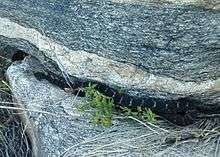Crotalus oreganus cerberus
| Crotalus oreganus cerberus | |
|---|---|
 | |
| Scientific classification | |
| Kingdom: | Animalia |
| Phylum: | Chordata |
| Subphylum: | Vertebrata |
| Class: | Reptilia |
| Order: | Squamata |
| Suborder: | Serpentes |
| Family: | Viperidae |
| Subfamily: | Crotalinae |
| Genus: | Crotalus |
| Species: | C. oreganus |
| Subspecies: | C. o. cerberus |
| Trinomial name | |
| Crotalus oreganus cerberus (Coues In Wheeler, 1875) | |
| Synonyms | |
Crotalus oreganus cerberus is a venomous pitviper subspecies[5] found in the southwestern United States.
Description
According to Wright and Wright (1957), adults grow to an average length of 78–109 cm (31–43 in). Klauber (1997) reports the maximum length to be less at 1,032 mm (40 5⁄8 in), with the smallest gravid female measuring 701 mm (27 5⁄8 in).[6] Hubbs and O'Connor (2012) list an adult size range of 812–1,219 mm (32.0–48.0 in).[7]
The color pattern consists of a dark grayish, brownish black, reddish brown, or blackish ground color, overlaid with a dorsal pattern of blotches that are rectangular anteriorly, becoming subhexagonal posteriorly, eventually becoming crossbands just before the tail. However, specimens also may be a uniform dark color without any clear dorsal pattern, or the dorsal blotches may be even darker and bordered with white, cream, or yellow transverse rows of scales, or the color pattern may be quite pale with a significant amount of yellow mixed in. A postocular stripe is evident in lightly colored specimens, but not so much in darker ones.[8]
Color change
Some adult Arizona black rattlesnakes can change color relatively quickly, an ability shared not only with chameleons but also with other snakes such as some species in the genus Tropidophis. Further research is needed to determine the mechanism and stimuli for this phenomenon in this rattlesnake.[7]
Common names
Arizona black rattlesnake, black rattlesnake, black diamond rattlesnake, brown rattlesnake, Cerberus rattlesnake, mountain diamond-back.[4] Also often incorrectly referred to as a timber rattlesnake.
Geographic range
Found in the United States, in Arizona from the Hualapai Mountains and Cottonwood Cliffs in the northwest of the state, southeast to the Santa Catalina, Rincon, Pinaleno and Blue Mountains. Also found at Steeple Rock, in extreme western New Mexico.[6] The type locality given is "San Francisco Mountains" (Coconino County, Arizona, USA).[1]
Diet
It preys upon suitably sized amphibians, reptiles, birds and their eggs, and mammals.[7]
Reproduction
Sexually mature females bear live young in broods of 4 to 21 neonates.[7] The Arizona black rattlesnake is the first species of snake observed to exhibit complex social behavior, and parenting behavior reminiscent of that in mammals. Females often remain with their young in nests for several weeks, and mothers have been observed cooperatively parenting their broods.[9]
See also
- List of crotaline species and subspecies
- Crotalus by common name
- Crotalus by taxonomic synonyms
- Crotalinae by common name
- Crotalinae by taxonomic synonyms
- Snakebite
References
- 1 2 McDiarmid RW, Campbell JA, Touré T. 1999. Snake Species of the World: A Taxonomic and Geographic Reference, vol. 1. Herpetologists' League. 511 pp. ISBN 1-893777-00-6 (series). ISBN 1-893777-01-4 (volume).
- ↑ Ashton, KG; de Queiroz, A (2001). "Molecular systematics of the western rattlesnake, Crotalus viridis (Viperidae), with comments on the utility of the d-loop in phylogenetic studies of snakes" (PDF). Molecular Phylogenetics and Evolution. 21 (2): 176–189. doi:10.1006/mpev.2001.1013.
- ↑ The Reptile Database. www.reptile-database.org.
- 1 2 Wright AH, Wright AA. 1957. Handbook of Snakes. 2 volumes. Comstock Publishing Associates. (7th printing, 1985). 1105 pp. ISBN 0-8014-0463-0.
- ↑ "Crotalus oreganus cerberus". Integrated Taxonomic Information System. Retrieved 1 August 2007.
- 1 2 Klauber LM. 1997. Rattlesnakes: Their Habitats, Life Histories, and Influence on Mankind. Second Edition. 2 volumes. Reprint, University of California Press, Berkeley. ISBN 0-520-21056-5.
- 1 2 3 4 Hubbs, Brian and Brendan O'Connor. 2012. A Guide to the Rattlesnakes and other Venomous Serpents of the United States. Tricolor Books. Tempe, Arizona, 129 pp. ISBN 978-0-9754641-3-7. (Crotalus cerberus, pp. 34-35.)
- ↑ Campbell JA, Lamar WW. 2004. The Venomous Reptiles of the Western Hemisphere. 2 volumes. Comstock Publishing Associates, Ithaca and London. 870 pp. 1500 plates. ISBN 0-8014-4141-2.
- ↑ Amerello, Melissa; Smith, Jeffrey; Slone, John (2011). "Family values: Maternal care in rattlesnakes is more than mere attendance". Nature Precedings. doi:10.1038/npre.2011.6671.1.
External links
| Wikimedia Commons has media related to Crotalus oreganus. |
- Crotalus oreganus at the Reptarium.cz Reptile Database. Accessed 12 August 2007.
- Arizona Black Rattlesnake, Crotalus viridis cerberus at the National Park Service. Accessed 18 June 2008.